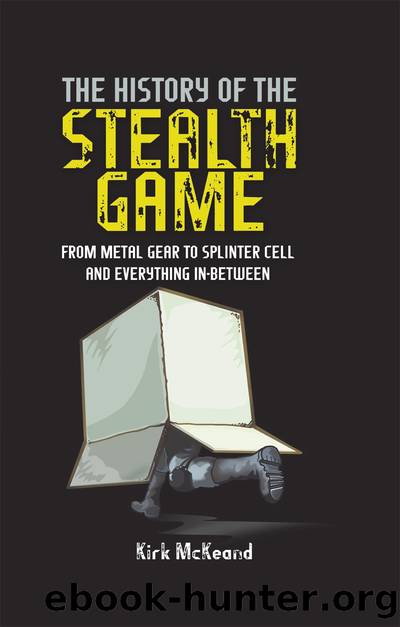The History of the Stealth Game by Kirk McKeand

Author:Kirk McKeand
Language: eng
Format: epub
Tags: GAMES & ACTIVITIES / Video & Mobile
Publisher: Pen & Sword Books
Published: 2022-07-08T00:00:00+00:00
------
Eidos-Montréal opened in November 2007 with just five employees. Without a single title to its name, its first game was to be Deus Ex 3, which would later become known as Deus Ex: Human Revolution.
âA lot of people said, âGuys, are you sure you want to start with that project? Youâre gonna hit a wall, youâre gonna have a bloody nose,ââ former Eidos-Montréal general manager Stephane DâAstous explains: âThe core team were people that were super talented, not afraid of challenges, super passionate. My role was to put the people, the environment, the spirit, and the passion in place.â
Even though he didnât leave the studio on the best of terms, DâAstous still holds onto that passion. Iâm talking to him over video conference and heâs wearing a Deus Ex 3 T-shirt that predates the projectâs name change to Human Revolution. It still fits like a glove. Partway through our chat, he pulls out a Game Informer magazine with the studioâs second project, Thief, on its cover.
Deciding what game Eidos-Montréal wanted to do first wasnât easy. Three options were on the table: Deus Ex, Thief, and Legacy of Kain. Ultimately, the team decided to take on Deus Ex and Thief because they felt like they were more viable for reinterpretation. Legacy of Kain would have been easier, but it wasnât as exciting. They decided to start with Deus Ex.
Tasked with creating a sequel to one of the most beloved, mechanically complex games of all time, creative director Jean-François Dugas had another thing to tick off first: Turn this empty room into a game studio.
âThe first guy I worked with on this project was Jonathan-Jacques Belletête, the art director,â Dugas explains. âWe were in this temporary office. We didnât have our desks, and we had to go into a storage unit, take some of the unscrewed tables, and put them together to put our computers on. It was a start-up kind of feel.â
There was just one problem: They couldnât figure out how to build the tables. âWhy did I jump into this crazy endeavor with two guys who canât put tables together properly?â Dugas remembers his colleague David Anfossi saying. âWe laughed about that. We were like, âYeah, I think weâre better at making games.ââ
Perhaps it would have been easier to smash the desks to pieces and build new desks from scratch. Thatâs essentially the approach the team had with Deus Ex. They wanted to retain the essence of Deus Ex while pushing the series forward. If weâre going to get lost in my shitty table analogy, they wanted to destroy the desks and turn them into hybrid standing desks. You see, while the original game had the benefit of launching at a time when developers were still figuring games out, Eidos-Montréalâs project was releasing in a different world.
In an interview with Jeremy Peel at Rock, Paper, Shotgun, game designer Ricardo Bare spoke briefly about showing his brother-in-law a build of the original Deus Ex. âMaking the game accessible was not something we were good at,â he said.
Download
This site does not store any files on its server. We only index and link to content provided by other sites. Please contact the content providers to delete copyright contents if any and email us, we'll remove relevant links or contents immediately.
Harry Potter and the Cursed Child: The Journey by Harry Potter Theatrical Productions(3983)
The Sports Rules Book by Human Kinetics(3597)
Molly's Game: From Hollywood's Elite to Wall Street's Billionaire Boys Club, My High-Stakes Adventure in the World of Underground Poker by Molly Bloom(2974)
A Knight of the Seven Kingdoms by George R R Martin(2635)
Quidditch Through the Ages by J.K. Rowling(2606)
Quidditch Through the Ages by J K Rowling & Kennilworthy Whisp(2585)
How To by Randall Munroe(2492)
Quidditch Through the Ages by Kennilworthy Whisp by J.K. Rowling(2443)
Quidditch through the Ages by J. K. Rowling(2382)
Quidditch Through The Ages by J. K. Rowling(2341)
Stacked Decks by The Rotenberg Collection(2283)
776 Stupidest Things Ever Said by Ross Petras(2279)
The Infinite Retina by Robert Scoble Irena Cronin(2258)
What If?: Serious Scientific Answers to Absurd Hypothetical Questions by Randall Munroe(2177)
Flowers For Algernon by Daniel Keyes(2167)
Beautiful Oblivion by Jamie McGuire(2155)
The Book of Questions: Revised and Updated by Gregory Stock Ph.d(2144)
Champions of Illusion by Susana Martinez-Conde & Stephen Macknik(2080)
Ready Player One: A Novel by Ernest Cline(2080)
